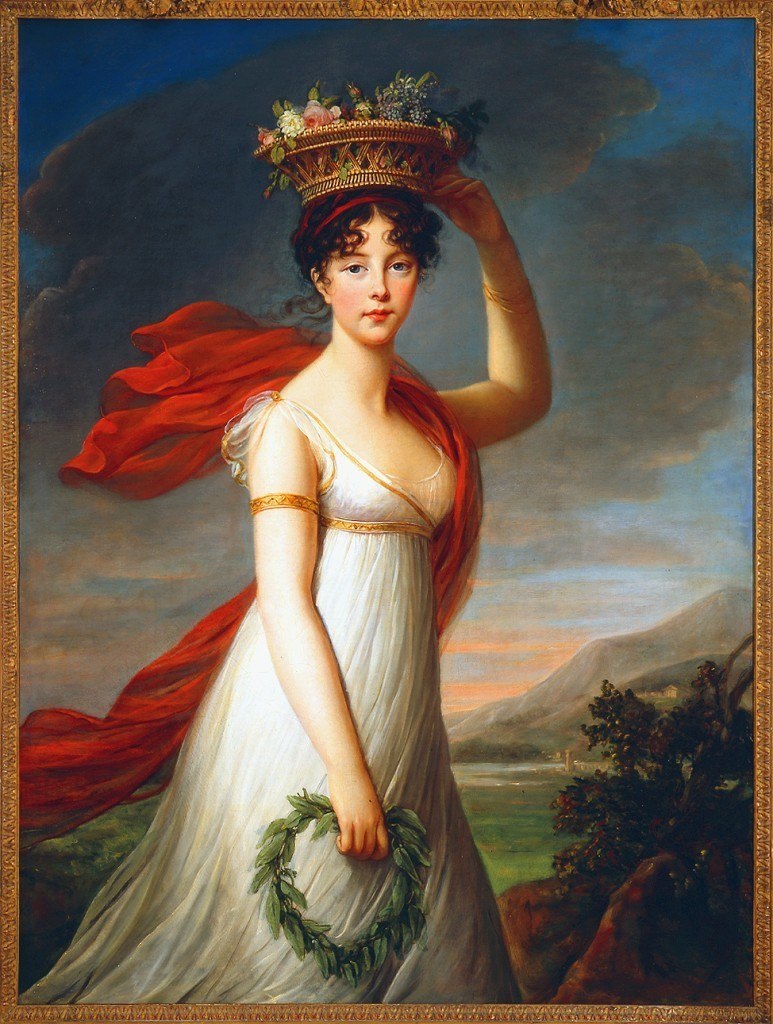
Elisabeth Vigée-lebrun
French, (1755–1842)
Julie as Flora, Roman Goddess Of Flowers
1799
Oil on canvas
Museum purchase
1983.5
Here, the artist’s daughter Julie (1780–1819) represents Flora, the Roman goddess of flowers, to symbolize youthful beauty. The flowing drapery was inspired by Greco-Roman attire. Vigée-Lebrun spent four years in Italy. She lived for a time in Naples, near the ancient Roman city of Pompeii, which fueled the imaginations of many artists during this period. The landscape here recalls the area’s mountainous coastline.
Vigée-Lebrun was one of the few women elected to the French Royal Academy of Painting and Sculpture (1783). Patronized by Queen Marie-Antoinette throughout the 1780s, Vigée-Lebrun fled France following the Revolution of 1789. From Italy, she traveled to St. Petersburg, Russia, where this work was created. There, Julie met and married a man of whom her mother deeply disapproved, shattering their close relationship. This is perhaps the last of many paintings she made of Julie.
More works of art in the category: European
Other ways to explore the collection
-
Tags See all
- Abstract (24)
- Abstract Expressionism (4)
- Akan (1)
- Allegory (4)
- American (4)
- Americana (1)
- Amphora (1)
- Animals (33)
- Antiquites (15)
- Apulian (4)
- Architecture (1)
- Art Deco (1)
- Art Nouveau (3)
- Ashanti (4)
- Ashcan School (3)
- Austrian (2)
- Bamileke (1)
- Beading (1)
- Beaker (1)
- Belgian (2)
- Book Club (1)
- British (17)
- Ceramic (46)
- Chalice (1)
- Children (12)
- Chinese (5)
- Chocolate (1)
- City (7)
- Cloisonne (1)
- Cochiti (1)
- Coffee Pot (1)
- Contemporary (13)
- Costa Rica (1)
- Couples (13)
- Dan (1)
- Dan-Ngere (1)
- Death (9)
- Decorative Arts (29)
- DMG (1)
- Dogs (4)
- Drawing (6)
- Dutch (6)
- Edo Period (4)
- Egypt (1)
- Eighteenth Century (21)
- Eleventh Century (1)
- Exhibition Opening (1)
- Expressionism (1)
- Figure (147)
- Fishing (2)
- Flemish (4)
- Florida (2)
- Flowers (15)
- Folk Art (7)
- Food (1)
- Fourteenth Century (4)
- French (35)
- Fruit (1)
- Fundraiser (1)
- Furniture (7)
- Genre (4)
- Georgian Era (1)
- German (4)
- Glass (12)
- Gold (2)
- Greek (4)
- Han Dynasty (2)
- Hopi (1)
- Hudson River School (3)
- Hungarian (2)
- Hydria (2)
- Igala (1)
- Incensario (1)
- Indian (11)
- Italian (8)
- Ivory Coast (1)
- Japanese (13)
- Kamba (1)
- Kano School (1)
- Korean (2)
- Koryo Dynasty (2)
- Krater (3)
- Kuyu (1)
- Landscape (1)
- Landscapes (38)
- Louis XV (1)
- Make Take activity (1)
- Marly (1)
- Mask (8)
- Mayan (2)
- Meiji (2)
- Men (53)
- Mende (1)
- Metal (2)
- Mexican (10)
- Ming Dynasty (1)
- Mixed Media (6)
- Moon (3)
- Moonlight (3)
- Music (1)
- Mythological (6)
- Native American (5)
- Nature (3)
- New York (3)
- New York School (2)
- Nigerian (2)
- Nineteenth Century (78)
- Ninth Century (1)
- Nude (8)
- Nupe (1)
- Orientalism (1)
- Painting (125)
- Panama (1)
- Pendant (1)
- Pende (1)
- Peruvian (1)
- Portraits (21)
- Qing Dynasty (1)
- Relief (13)
- Religious (28)
- Renaissance (1)
- Rococo (1)
- Roman (2)
- Romanticism (2)
- Ruins (1)
- Russian (1)
- San Ildefonso (2)
- Scientific (1)
- Scottish (1)
- Screen (3)
- Scroll (3)
- Sculpture (53)
- Seascapes (9)
- Self-portrait (1)
- Seventeenth Century (17)
- Silver (10)
- Sixteenth Century (8)
- Sixth Century (1)
- Soldier (4)
- Spanish (4)
- Still Life (9)
- Studio Glass (5)
- Sui Dynasty (1)
- Swiss (1)
- Tea (2)
- Teapot (1)
- Tenth Century (3)
- Thai (2)
- Tibet (3)
- Tour (1)
- Twelfth Century (1)
- Twentieth Century (114)
- Vanitas (1)
- Vase (9)
- Victorian (1)
- Victorian Era (1)
- Video (3)
- Washington Color School (1)
- West Africa (1)
- Women (67)
- Works on Paper (17)
- Yoruba (4)
- Zuni (1)